Role Novelist Name Miguel Cervantes | Signature | |
 | ||
Occupation Soldier, novelist, poet, playwright, accountant Notable works Don QuixoteEntremesesNovelas ejemplares Movies Man of La Mancha, Don Quixote Books Don Quixote, Novelas ejemplares, La Galatea, Los trabajos de Persiles y, Viaje al Parnaso Similar People William Shakespeare, Niccolo Machiavelli, Lope de Vega, Francisco de Quevedo, Gabriel Garcia Marquez | ||
Miguel de cervantes don quixote
Miguel de Cervantes Saavedra ( or ; [miˈɣel de θerˈβantes saˈβeðɾa]; 29 September 1547 (assumed) – 22 April 1616) was a Spanish writer who is widely regarded as the greatest writer in the Spanish language and one of the world's pre-eminent novelists.
Contents
- Miguel de cervantes don quixote
- Miguel de Cervantes Educational Bios for Kids
- Birth and early life
- Military service and captivity
- Later life
- Literary pursuits
- Death
- Works
- Don Quixote
- Novelas ejemplares Exemplary Novels
- Los Trabajos de Persiles y Sigismunda
- Poetry
- Viaje del Parnaso
- Plays
- La Numancia
- Legacy
- References in other works
- Ballets
- Films
- Literature
- Music
- Visual art
- Place
- Ethnic and religious heritage
- Likeness
- References

His major work, Don Quixote, is considered the first modern novel, a classic of Western literature, and is regarded among the best works of fiction ever written. His influence on the Spanish language has been so great that the language is often called la lengua de Cervantes ("the language of Cervantes"). He has also been dubbed El príncipe de los ingenios ("The Prince of Wits").

In 1569, in forced exile from Castile, Cervantes moved to Rome, where he worked as chamber assistant of a cardinal. Then he enlisted as a soldier in a Spanish Navy infantry regiment and continued his military life until 1575, when he was captured by Barbary pirates. After five years of captivity, he was released on payment of a ransom by his parents and the Trinitarians, a Catholic religious order, and he returned to his family in Madrid.
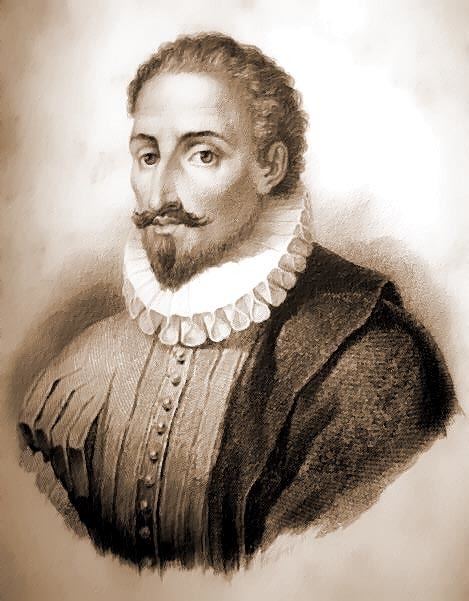
In 1585, Cervantes published a pastoral novel titled La Galatea. He worked as a purchasing agent for the Spanish Armada and later as a tax collector for the government. In 1597, discrepancies in his accounts for three years previous landed him in the Crown Jail of Seville.
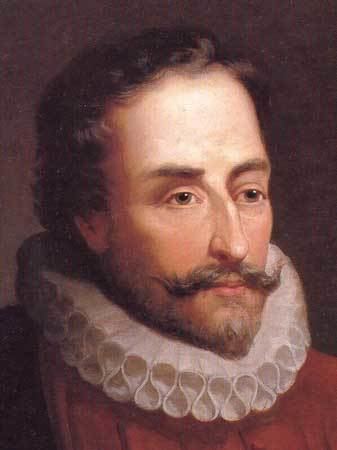
In 1605, Cervantes was in Valladolid when the immediate success of the first part of his Don Quixote, published in Madrid, signaled his return to the literary world. In 1607, he settled in Madrid, where he lived and worked until his death. During the last nine years of his life, Cervantes solidified his reputation as a writer, publishing Novelas ejemplares (Exemplary Novels) in 1613, Viaje al Parnaso (Journey to Parnassus) in 1614, and Ocho comedias y ocho entremeses and the second part of Don Quixote in 1615. His last work, Los trabajos de Persiles y Sigismunda ("The Works of Persiles and Sigismunda"), was published posthumously in 1617.
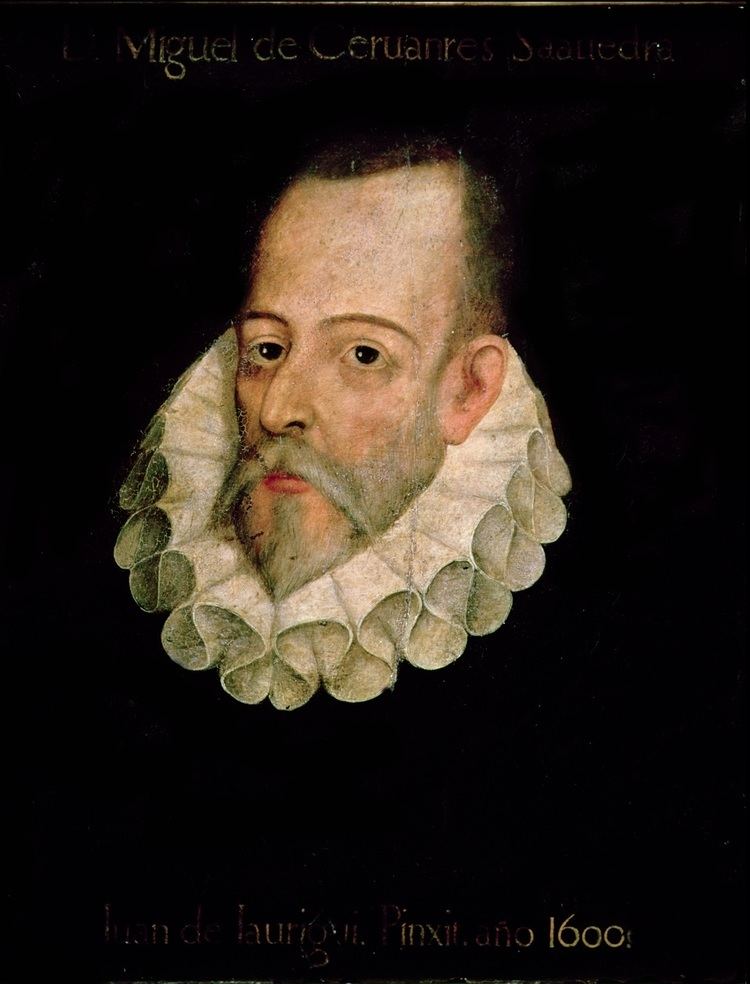
Miguel de Cervantes | Educational Bios for Kids
Birth and early life
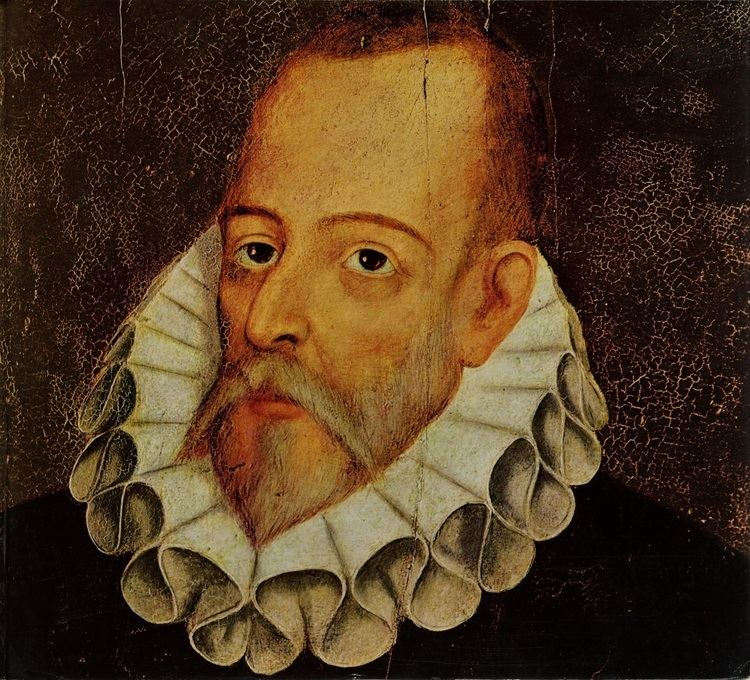
It is assumed that Cervantes was born in Alcalá de Henares, a Castilian city about 35 kilometres (22 mi) northeast from Madrid, probably on 29 September (the feast day of Saint Michael the Archangel) 1547. The probable date of his birth was determined from records in the church register, given the tradition of naming a child after the feast day of his birth. He was baptized in Alcalá de Henares on 9 October 1547 at the parish church of Santa María la Mayor. The register of baptisms records the following:

On Sunday, the ninth day of the month of October, the year of our Lord one thousand five hundred forty and seven, Miguel, son of Rodrigo Cervantes and his wife Leonor, was baptised; his godfathers were Juan Pardo; he was baptised by the Reverend Bachelor Bartolomé Serrano, Priest of Our Lady. Witnesses, Baltasar Vázquez, Sexton, and I, who baptised him and signed this in my name. Bachelor Serrano.
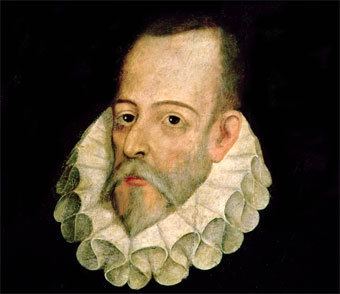
Miguel at birth was not surnamed Cervantes Saavedra. He adopted the "Saavedra" name as an adult. By Spanish naming conventions, his second surname was that of his mother, Cortinas. His father, Rodrigo, was a barber-surgeon of Galician extraction from Córdoba, who set bones, performed bloodlettings, and attended to "lesser medical needs"; at that time, it was common for barbers to do surgery as well. His paternal grandfather, Juan de Cervantes, was an influential lawyer who held several administrative positions. His uncle was mayor of Cabra for many years. His mother, Leonor de Cortinas, was a native of Arganda del Rey and the third daughter of a nobleman, who lost his fortune and had to sell his daughter into matrimony in 1543. This led to a very awkward marriage and several affairs by Rodrigo. Leonor died on 19 October 1593.
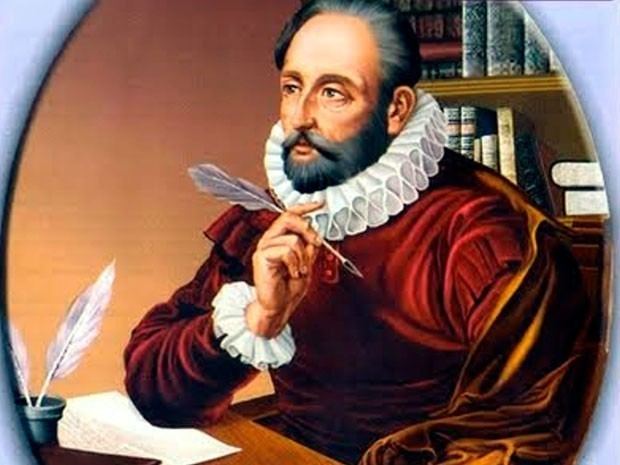
Little is known of Cervantes' early years. It seems he spent much of his childhood moving from town to town with his family, eventually enrolling in The Imperial School, a Jesuit educational establishment for boys in Madrid. During this time, he met a young barmaid named Josefina Catalina de Parez. The couple fell madly in love and plotted to run away together. Her father discovered their plans and forbade Josefina from ever seeing Cervantes again, perhaps because of the young man's poor prospects of ever rising from poverty—Miguel's own father was embargoed for debt. The court records of the proceedings show a very poor household. While some of his biographers argue that he studied at the University of Salamanca, there is no solid evidence for supposing that he did so. There has been speculation also that Cervantes studied with the Jesuits in Córdoba or Seville.
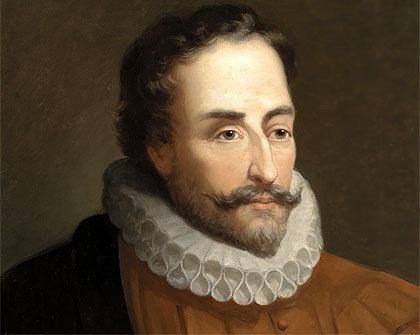
His siblings were Andrés (1543), Andrea (1544), Luisa (1546), Rodrigo (1550), Magdalena (1554) and Juan—known solely because he is mentioned in his father's will.
Military service and captivity
The reasons that forced Cervantes to leave Spain remain uncertain. Possible reasons include that he was a "student" of the same name, a "sword-wielding fugitive from justice", or fleeing from a royal warrant of arrest, for having wounded a certain Antonio de Sigura in a duel. Like many young Spanish men who wanted to further their careers, Cervantes left for Italy. In Rome, he focused his attention on Renaissance art, architecture, and poetry – knowledge of Italian literature is discernible in his work. He found "a powerful impetus to revive the contemporary world in light of its accomplishments". Thus, Cervantes' stay in Italy, as revealed in his later works, might be in part a desire for a return to an earlier period of the Renaissance.
By 1570, Cervantes had enlisted as a soldier in a regiment of the Spanish Navy Marines, Infantería de Marina, stationed in Naples, then a possession of the Spanish crown. He was there for about a year before he saw active service. In September 1571, Cervantes sailed on board the Marquesa, part of the galley fleet of the Holy League (a coalition of Pope Pius V, Spain, the Republic of Venice, the Republic of Genoa, the Duchy of Savoy, the Knights Hospitaller based in Malta, and others, under the command of Philip II of Spain's illegitimate half brother, John of Austria) that defeated the Ottoman fleet on October 7 in the Battle of Lepanto, in the Gulf of Patras. Though taken down with fever, Cervantes refused to stay below and asked to be allowed to take part in the battle, saying he would rather die for his God and his king than keep under cover. He fought on board a vessel and received three gunshot wounds – two in the chest and one which rendered his left arm useless. In Journey to Parnassus he was to say that he "had lost the movement of the left hand for the glory of the right" (referring to the success of the first part of Don Quixote). Cervantes looked back on his conduct in the battle with pride: he believed he had taken part in an event that shaped the course of European history.
After the Battle of Lepanto, Cervantes remained in hospital in Messina, Italy, for about six months, before his wounds healed enough to allow his joining the colors again. From 1572 to 1575, based mainly in Naples, he continued his soldier's life: he participated in expeditions to Corfu and Navarino, and saw the fall of Tunis and La Goulette to the Turks in 1574.
On 6 or 7 September 1575, Cervantes set sail on the galley Sol from Naples to Barcelona, with letters of commendation to the king from the Duke of Sessa. On the morning of 26 September, as the Sol approached the Catalan coast, it was attacked by Ottoman pirates and he was taken to Algiers, which had become one of the main and most cosmopolitan cities of the Ottoman Empire, and was kept there in captivity between the years of 1575 and 1580. After five years as a slave in Algiers, and four unsuccessful escape attempts, he was ransomed by his parents and the Trinitarians and returned to his family in Madrid. Not surprisingly, this traumatic period of Cervantes' life supplied subject matter for several of his literary works, notably the Captive's tale in Don Quixote and the two plays set in Algiers – El trato de Argel (Life in Algiers) and Los baños de Argel (The Dungeons of Algiers) – as well as episodes in a number of other writings, although never in straight autobiographical form.
Later life
Cervantes led a middle-class life after his return to Spain. Like almost all authors of his day, he was unable to support himself through his writings. Two periods of his life that are very well documented are his years of work in Andalucía as a purchasing agent for the Spanish navy (i.e., the King). This led to his imprisonment for a few months in Seville after a banker where he had deposited Crown funds went bankrupt. (Since Cervantes says that Don Quixote was "engendered" in a prison, that is presumably a reference to this episode.) He also worked as a tax collector, travelling from town to town collecting back taxes due the crown. He applied unsuccessfully for "one of four vacant positions in the New World", one of them as an accountant for the port of Cartagena. At the time he was living in Valladolid, then briefly the capital (1601–1606), and finishing Don Quixote Part One, he was presumably working in the banking industry, or a related occupation where his accounting skills could be put to use. He was turned down for a position as secretary to Pedro Fernández de Castro y Andrade, the Count of Lemos, although he did receive some type of pension from him, which permitted him to write full-time during his final years (about 1610 to 1616). His last known written words – the dedication to Los Trabajos de Persiles y Sigismunda – were written, he tells us, after having received Extreme Unction. He died in 1616 of type II diabetes. His burial place in Madrid was reportedly rediscovered in March 2015, but his unpublished manuscripts were mostly lost.
Literary pursuits
In Esquivias, Toledo, on 12 December 1584, he married the much younger Catalina de Salazar y Palacios (born Esquivias – d. 31 October 1626), daughter of Fernando de Salazar y Vozmediano and Catalina de Palacios. Her uncle Alonso de Quesada y Salazar is said to have inspired the character of Don Quixote. Over the next 20 years, Cervantes led a nomadic existence, working as a purchasing agent for the Spanish Armada and as a tax collector. He suffered bankruptcy and was imprisoned at least twice (1597 and 1602) for irregularities in his accounts. Between 1596 and 1600, he lived primarily in Seville. In 1606, Cervantes settled in Madrid, where he remained for the rest of his life.
In 1585 Cervantes published his first major work, La Galatea, a pastoral romance, at the same time that some of his plays, now lost – except for El trato de Argel (where he dealt with the life of Christian slaves in Algiers) and El cerco de Numancia – were playing on the stages of Madrid. La Galatea received little contemporary notice; and Cervantes never wrote the continuation for it, which he repeatedly promised to do. Cervantes next turned his attention to drama, hoping to derive an income from that source, but his plays failed. Aside from his plays, his most ambitious work in verse was Viage del Parnaso (1614) – an allegory which consisted largely of a rather tedious though good-natured review of contemporary poets. Cervantes himself realized that he was deficient in poetic talent.
If a remark which Cervantes himself makes in the prologue of Don Quixote is to be taken literally, the idea of the work (though hardly the writing of its First Part, as some have maintained) occurred to him while in jail. Cervantes' idea was to give a picture of real life and manners, and to express himself in clear language. The intrusion of everyday speech into a literary context was acclaimed by the reading public. The author stayed poor until January 1605, when the first part of Don Quixote appeared.
The popularity of Don Quixote led to the publication of an unauthorized continuation of it by an unknown writer, who masqueraded under the name of Alonso Fernández de Avellaneda. Cervantes produced his own continuation, or Second Part, of Don Quixote, which made its appearance in 1615. He had promised the publication of a second part in 1613 in the foreword to the Novelas ejemplares (Exemplary Novels), a year before the publication of Avellaneda's book. Don Quixote has been regarded chiefly as a novel of purpose. It is stated again and again that he wrote it in order to satirize the chivalric romance and to challenge the popularity of a form of literature that had been a favourite of the general public for more than a century.
Don Quixote certainly reveals much narrative power, considerable humour, a mastery of dialogue, and a forceful style. Of the two parts written by Cervantes, perhaps the first is the more popular with the general public – containing the famous episodes of the tilting at windmills, the attack on the flock of sheep, the vigil in the courtyard of the inn, and the episode with the barber and the shaving basin. The second part shows more constructive insight, better delineation of character, improved style, and more realism and probability in its action. Most people agree that it is richer and more profound.
In 1613, he published a collection of tales, the Exemplary Novels, some of which had been written earlier. The picaroon strain, already made familiar in Spain through the Picaresque novels of Lazarillo de Tormes and his successors, appears in one or another of them, especially in the Rinconete y Cortadillo. In 1614, he published the Viage del Parnaso and in 1615, the Eight Comedies and Eight New Interludes. At the same time, Cervantes continued working on Los Trabajos de Persiles y Sigismunda, a novel of adventurous travel, completed just before his death, and appearing posthumously in January 1617.
Death
Cervantes died in Madrid on 22 April 1616 and was buried the next day, 23 April. The cause of his death, according to Antonio López Alonso, a modern physician who has examined the surviving documentation, was type-2 diabetes, a result of a cirrhosis of the liver. This is the best explanation for the intense thirst he complained of. The cirrhosis was not caused by alcoholism; Cervantes was too productive, especially in his final years, to have been an alcoholic. For many years 23 April 1616 was shown as the date of his death in some references, and is still the date on which his death is widely commemorated (along with that of William Shakespeare, although the date for Cervantes was according to the Gregorian calendar while the date for Shakespeare was according to the Julian calendar and therefore 10 days later in real time).
In accordance with Cervantes' will, he was buried in the neighboring Convent of the Barefoot Trinitarians, in central Madrid. His bones went missing in 1673 when building work was done at the convent, and were known to have been taken to a different convent and returned later. A project promoted and led by Fernando de Prado began in 2014 to rediscover his remains.
In January 2015, it was reported that researchers searching for Cervantes' remains had found part of a casket bearing his initials, MC, at the convent. Francisco Etxeberria, the forensic anthropologist leading the search, said: "Remains of caskets were found, wood, rocks, some bone fragments, and indeed one of the fragments of a board of one of the caskets had the letters 'M.C.' formed in tacks." The first significant search for Cervantes' remains had been launched in May 2014 and had involved the use of infrared cameras, 3D scanners and ground-penetrating radar. The team had identified 33 alcoves where bones could be stored.
On 17 March 2015, it was reported that Cervantes' remains had been discovered, along with those of his wife and others, at the Convent of the Barefoot Trinitarians. Through documentary research, archaeologists stated that they had identified the remains as those of Cervantes. Clues from Cervantes' life, such as the loss of the use of his left hand at age 24 and the fact that he had taken at least one bullet to the chest, were hoped to help in the identification. Historian Fernando de Prado had spent more than four years trying to find funding before Madrid City Council had agreed to pay. DNA testing would now be carried out in an attempt to confirm the findings.
On 11 June 2015, Cervantes was given a formal burial at a Madrid convent, containing a monument holding bone fragments that were believed to have been the author's. The city mayor Ana Botella and military attended the event.
Works
Don Quixote
Don Quixote (spelled "Quijote" in modern Spanish) is two separate volumes, now nearly always published as one, that cover the adventures of Don Quixote de la Mancha, a hero who carries his enthusiasm and self-deception to unintentional and comic ends. On one level, Don Quixote works as a satire of the romances of chivalry, which, though still popular in Cervantes' time, had become an object of ridicule among more demanding critics. The choice of a madman as hero also served a critical purpose, for it was "the impression of ill-being or 'in-sanity,' rather than a finding of dementia or psychosis in clinical terms, that defined the madman for Cervantes and his contemporaries." Indeed, the concept of madness was "associated with physical or moral displacement, as may be seen in the literal and figurative sense of the adjectives eccentric, extravagant, deviant, aberrant, etc." The novel allows Cervantes to illuminate various aspects of human nature. Because the novel, particularly the first part, was written in individually published sections, the composition includes several incongruities. Cervantes pointed out some of these errors in the preface to the second part; but he disdained to correct them, because he conceived that they had been too severely condemned by his critics. Cervantes felt a passion for the vivid painting of character. Don Quixote is noble-minded, an enthusiastic admirer of everything good and great, yet having all these fine qualities accidentally blended with a relative kind of madness. He is paired with a character of opposite qualities, Sancho Panza, a man of low self-esteem, who is a compound of grossness and simplicity.
Don Quixote is cited as the first classic model of the modern romance or novel, and it has served as the prototype of the comic novel. The humorous situations are mostly burlesque, and it includes satire. Don Quixote is one of the Encyclopædia Britannica's Great Books of the Western World, while the Russian author Fyodor Dostoyevsky called it "the ultimate and most sublime work of human thinking". It is in Don Quixote that Cervantes coined the popular phrase "the proof of the pudding is in the eating" (por la muestra se conoce el paño), which still sees heavy use in the shortened form of "the proof is in the pudding", and "who walks much and reads much, knows much and sees much" (quien anda mucho y lee mucho, sabe mucho y ve mucho).
Novelas ejemplares (Exemplary Novels)
Cervantes intended his novels should be to Spanish nearly what the novellas of Boccaccio were to Italians. Some are anecdotes, some are romances in miniature, some are serious, some comic; they are written in a light, smooth, conversational style.
Four novelas, though favorites in Cervantes' day, are perhaps of less interest today than the rest: El amante liberal, La señora Cornelia, Las dos doncellas, and La española inglesa. The theme common to these is pairs of lovers (couples) separated by lamentable and complicated events; they are finally reunited and find the happiness they have longed for. The heroines are all beautiful and of perfect behavior; they and their lovers are capable of the highest sacrifices; and they try to elevate themselves to the ideal of moral and aristocratic distinction which illuminates their lives. In El amante liberal, the beautiful Leonisa and her lover Ricardo are carried off by Turkish pirates. Both fight against serious material and moral dangers. Ricardo conquers all obstacles, returns to his homeland with Leonisa, and is ready to renounce his passion and to hand her over to her former lover in an outburst of generosity; but Leonisa's preference naturally settles on Ricardo in the end.
Another group of "exemplary" novels is formed by La fuerza de la sangre, La ilustre fregona, La gitanilla, and El celoso extremeño. The first three offer examples of love and adventure happily resolved, though only on the surface and in purely social terms, for the marriages that occur at their conclusions are morally deficient and repugnant to discerning readers. The last of the four unravels itself tragically. It deals with the aged Felipe Carrizales, who, after traveling widely and becoming rich in America, decides to marry, taking all the precautions necessary to forestall being betrayed, as he had in his youth. He weds a very young girl and isolates her from the world by enclosing her in a well-guarded house with no windows. In spite of these defensive measures, a bold youth succeeds in penetrating the fortress of conjugal honour and one day Carrizales surprises his wife asleep in the arms of this would-be seducer. Carrizales mistakenly assumes that his wife has succumbed to the youth's advances, whereas in fact she did not. Nevertheless, Carrizales pardons those whom he believes to be adulterers, recognizing that he is more to blame than they, and dies of sorrow over the grievous error he has committed. Cervantes here calls into question the social ideal of honour to privilege instead free will and the value of the individual. Rinconete y Cortadillo, El casamiento engañoso, El licenciado Vidriera, and the untitled novella known today as El coloquio de los perros, four works of art which are concerned more with the personalities of the characters than with the subject matter, form the final group of stories. The protagonists are, respectively, two young vagabonds, Pedro del Rincón and Diego Cortado, Lieutenant Campuzano, a student – Tomás Rodaja (who goes mad and believes he has become glass, and who makes many remarks on society and customs of the time) and finally two dogs, Cipión and Berganza, whose wandering existence serves as a commentary on the picaresque novel.
The two young vagabonds of Rinconete y Cortadillo come by chance to Seville, and also attracted by the riches and disorder that 16th-century commerce with the Americas had brought to that metropolis. There they come into contact with a brotherhood of thieves, the Thieves' Guild, led by Monipodio, whose house is the headquarters of the Sevillian underworld. The solemn ritual of this band of ruffians is all the more comic for being presented in Cervantes' drily humorous style.
Los Trabajos de Persiles y Sigismunda
Cervantes finished the romance of The Labors of Persiles and Sigismunda shortly before his death. The idea of this romance was not new and Cervantes appears to imitate Heliodorus. The work is a romantic description of travels, both by sea and land. Real and fabulous geography and history are mixed together and, in the second half of the romance, the scene is transferred to Spain and Italy.
Poetry
Some of his poems are found in La Galatea. He also wrote Dos Canciones à la Armada Invencible. His best work, however, is found in the sonnets, particularly Al Túmulo del Rey Felipe en Sevilla. Among his most important poems, Canto de Calíope, Epístola a Mateo Vázquez, and the Viaje del Parnaso (Journey to Parnassus – 1614) stand out. The latter is his most ambitious work in verse, an allegory which consists largely of reviews of contemporary poets. Compared to his ability as a novelist, Cervantes is often considered a mediocre poet.
Viaje del Parnaso
The prose of the Galatea, which is in other respects so beautiful, is occasionally overloaded with epithet. Cervantes displays a totally different kind of poetic talent in the Viaje del Parnaso, an extended commentary on the Spanish authors of his time.
Plays
Comparisons to more famous playwrights, those that use more popular structures and have more authority over the world of theatre, have diminished the reputation of his plays; but two of them (El Trato de Argel and La Numancia – 1582) made an impact. El Trato de Argel is written in 5 acts; based on his experiences as a captive of the Moors, the play deals with the life of Christian slaves in Algiers. La Numancia is a description of the siege of Numantia by the Romans. It details the horrors of the siege, and has been described as devoid of the requisites of dramatic art (he ignores structure and changes scheme and syllables per line many times throughout). Cervantes's output published in his lifetime consists of 16 dramatic works including eight full-length plays (Spanish links to plays included):
He also wrote 8 short farces (entremeses):
These plays and entremeses made up Ocho Comedias y ocho entire messes nuevos, nunca representados (Eight Comedies and Eight New Interludes, Never Before Performed) which appeared in 1615. The dates and order of composition of Cervantes' entremeses are unknown. Faithful to the spirit of Lope de Rueda, Cervantes endowed them with novelistic elements, such as simplified plot, the type of descriptions normally associated with a novel, and character development. Cervantes included some of his dramas among the works he was most satisfied with.
It is thought that he above all wanted to be a dramatist, to see his plays reach fruition. He thought that if only people with standing would view his works, they would see what he had to offer. the evidence is so strong for this that, "In all probability he would have given all the success of 'Don Quixote,' nay, would have seen every copy of 'Don Quixote' burned in the Plaza Mayor, for one such success as Lope de Vega was enjoying on an average once a week." This is shown with his lack of care for Don Quixote when it was published. It was strung together, and not cherished as a proud father would a newborn, but as a writer would a story that should only serve to relieve boredom and springboard other ideas
La Numancia
This play is a dramatization of the long and brutal siege of the Celtiberian town Numantia, Hispania, by the Roman forces of Scipio Africanus.
Cervantes invented, along with the subject of his piece, a peculiar style of tragic composition; and, in doing so, he did not pay much regard to the theory of Aristotle. His object was to produce a piece full of tragic situations, combined with the charm of the marvellous. In order to accomplish this goal, Cervantes relied heavily on allegory and on mythological elements.
The tragedy is written in conformity with no rules, save those which the author prescribed for himself, for he felt no inclination to imitate the Greek forms. The play is divided into four acts, jornadas; and no chorus is introduced. The dialogue is sometimes in tercets, and sometimes in redondillas, and for the most part in octaves – without any regard to rule.
Legacy
During his life, Cervantes was primarily known as a writer of comedy, which was how Don Quixote Part I was viewed in his day. His Exemplary Novels were better received than Don Quixote and allowed him to publish his plays and entremeses, Viaje del Parnaso, Part II of Don Quixote, and (by his widow) Los Trabajos de Persiles y Sigismunda. He then faded into semi-obscurity. Interest in him first revived in England in the 18th century, first by the deluxe edition of Tonson, for which the first biographical sketch was written (1738), and then by the scholarly editor John Bowle (writer), who was the first to call Cervantes a "classic" author. This began his influence on other novelists and then an intense interest by the German romantics in the late 18th and early 19th centuries. In 1805 (the bicentennial of the publication of Don Quixote Part I), and 1816 (the bicentennial of Cervantes' death), nothing happened. The tricentenial, 1905, saw a great wave of celebrations in Spain. The year 2016, the 400th anniversary of Cervantes' death, saw the production of Cervantina, a celebration of the author's plays by the Compañía Nacional de Teatro Clásico in Madrid.
Cervantes' novel Don Quixote has had a tremendous influence on the development of prose fiction. It has been translated into all major languages and has appeared in 700 editions. The first translation was in English, made by Thomas Shelton in 1608 (Part I only ), but not published until 1612. Shelton renders some Spanish idioms into English so literally that they sound nonsensical when translated. As an example Shelton always translates the word dedos as fingers, not realizing that dedos can also mean inches. (In the original Spanish, for instance, a phrase such as una altura de quince dedos, which makes perfect sense in Spanish, would mean "fifteen inches high" in English, but a translator who renders it too literally would translate it as "fifteen fingers high".
Carlos Fuentes raised the possibility that Cervantes and Shakespeare were the same person, in the sense that Homer, Dante, Defoe, Dickens, Balzac, and Joyce are all the same writer whose spirit wanders through the centuries. Fuentes noted that "Cervantes leaves the page open where the reader knows himself read and the author written."
Sigmund Freud was greatly influenced by "El coloquio de los perros", which has been called the origin of psychoanalysis. In it, only one character tells his story; the other listens, occasionally making comments. At the center of the dog's story is a sexual event. Freud stated that he learned Spanish so as to read Cervantes in the original, and he signed 55 letters with the name of the character (dog) Cipión.
The Biblioteca Virtual Miguel de Cervantes, the largest digital archive of Spanish-language historical and literary works in the world, is named after the author.
References in other works
Don Quixote has been the subject of a variety of works in other fields of art, including:
Ballets
Films
Literature
Don Quixote's influence can be seen in the work of:
Music
Opera
Operetta
Ballet
Incidental music
Orchestral
Musicals
Songs
Gordon Lightfoot:[[Don Quixote(Lightfoot song and album)(1972)
Piano
Visual art
Place
Cervantes was named after him.
Ethnic and religious heritage
Modern scholars have suggested that he may have descended from a New Christian or Converso background, i.e., that his ancestors, prior to 1492, had been Jews. Leandro Rodriguez of the University of Lausanne (Don Miguel, Judío de Cervantes, 1992) has written that the places, foliage, distances and sounds in the city of Cervantes, Lugo prove that the setting for the Don Quixote story took place there. Rodriguez also says that "Saavedra" is believed to refer to the area of Spain known as La Mancha, but was rather set near Zamora, Spain and that la mancha ("the stain") refers to his converso ("forced convert from Judaism") background. Advocates of the New Christian theory, first set forth by Américo Castro, often suggest Cervantes' mother was a converso as well. The theory rests almost exclusively on circumstantial evidence but would explain some mysteries of Cervantes' life. It has been supported by authors such as Anthony Cascardi and Eisenberg. Others, such as Claudio Sánchez-Albornoz (or Francisco Olmos Garcia, who considers it a "tired issue" and only supported by Américo Castro) reject the theory strongly.
One forgotten fact remains that the monastery of Saint Daniel in Hadath El Joubbeh in northern Lebanon harbors a rare document of a noblemen family of Karam tracing back Cervantes to an ancient patriarch, Simonus De Karam Cervantos Kfar Chmim, locally thought to be the great-grandfather of the author and a pillar of early Spanish linguistics.
Likeness
Although the portrait of Cervantes attributed to Juan de Jáuregui is the one most associated with the author, there is no known portrait that is really a true likeness.
The oil painting Retrato de un caballero desconocido (Portrait of an Unknown Gentleman), painted by El Greco in Toledo between 1600 and 1605, and on display at the Museo del Prado, has also been cited as a possible portrait of Cervantes, based on the fact that he was living near Toledo in 1604 and that he knew people within El Greco's circle of friends.
The 1859 portrait by Luis de Madrazo, which the painter himself stated is based on his own imagination, is currently at the Biblioteca Nacional de España.
The Spanish euro coins of €0.10, €0.20, and €0.50 bear an image of a bust of Cervantes.
